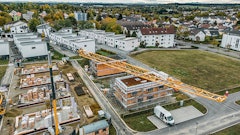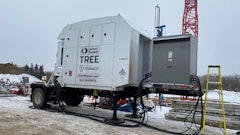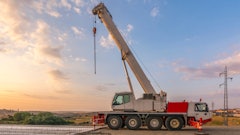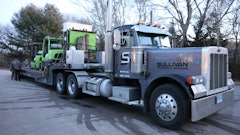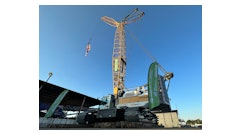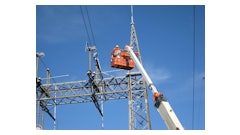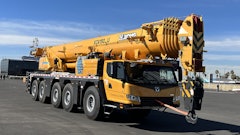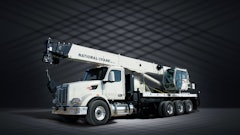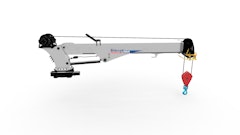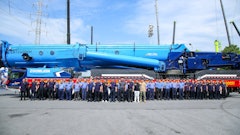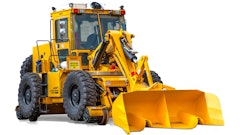
The challenge:
Place a 49-foot-long steel bridge over train tracks and onto supports with laser-like precision from a small working area in a residential neighborhood.
The players:
Steil Kranarbeiten
TKP Krächan
The process:
In June 2015, German contractor Steil Kranarbeiten was tasked with removing an old bridge at risk of collapse and installing a new, 49-foot-long, 73-ton steel bridge in Kirkel, Germany.
Before the new bridge could be put in place, the old one had to give way. A structure from the ‘60s, the bridge was considered to be at risk of collapse, and had been closed off to vehicles for quite a while. Accordingly, the run-down bridge was removed two months prior to the new bridge installation in a night shift that spanned multiple hours and saw the old structure lifted out after being split into eight sections.
“Since both the old and the new bridges cross over the Paris-Mannheim ICE train route, the overhead lines had to be disconnected from the grid before the lifts were carried out. We were asked to disrupt the Intercity-Express service as little as possible, this meant that we only had a time window of a few hours in both cases,” reports Martin Mittler, who is in charge of resource planning at Steil and was one of the people responsible for the project.
The Steil team used a a Terex AC 350/6 all terrain crane to remove the bridge. The contractor then brought in a Terex Superlift 3800 lattice boom crawler crane to complete the new bridge's installation.
Tight space conditions on site
The Steil team did not just face a tight schedule but also challenging conditions. The worksite was right in the middle of a residential area, leaving the team with precious little space and making it difficult both to get the Superlift 3800 crane’s components to the site with a total of 19 trucks and to set it up with a Terex AC 350/6 assist crane.
“Fortunately, though, the Superlift 3800 crane is really easy to transport, and that made our lives a lot easier. In fact, the modular quick-connect system, which makes it possible to split the crane’s basic structure into two parts, was one of the reasons why the Superlift 3800 was our crane of choice for this project,” Mittler points out. This enabled crane operators Daniel and Mike Schulz to set up the lattice boom crane within the allotted time frame of only two days despite the adverse conditions.
The unit was set up with an LH1 configuration with a 138-foot main boom, 226 tons of superstructure counterweight, and 55 tons of central ballast. However, the working area for the crane had to first be prepared with red ironwood crane mats, as the unstable ground would have otherwise been unable to bear the machine’s weight.
Precision work: a lift requiring a deft touch
Once the crane was in place, the crane and the working area were ready for lifting the new bridge. The structure was delivered in two sections and welded on-site, resulting in a total weight of 77 tons, including the required slinging gear. After the load was meticulously rigged so that it would be perfectly balanced, the power to the overhead lines was turned off at 11:30 p.m. and the lift started.
Crane operator Daniel Schulz started by lifting the bridge, which was rigged at four attachment points, to a height of 20 feet at a working radius of 85 feet, in order to then swing it over the tracks with a skillful turn. He then increased the working radius to approximately 98 feet by lowering the boom and moved forward with the Superlift 3800 crawler crane by about one meter. That’s where the trickiest part of the lift came in.
“We had to set the bridge down on supports with laser-like precision to make sure it was in the perfect position. Thankfully, the Superlift 3800 is the perfect machine for that kind of precision work, as it has extremely sensitive controls that let you apply just the right touch. In the end, that made the challenge easy to handle,” Schulz says while explaining what he considers to be one of the most important advantages of this Terex crane.
“When our customers hear that we’re using our Superlift 3800 crane with its standard fall protection system, they know that we’re literally on the safe side during assembly at the site, which makes coordination much easier and saves us from having to sort out that type of detail,” Mittler explains.
Project Manager Burghard Hass, who works for the company that fabricated the bridge — Dillingen-based Stahlbau Schäfer — was also tremendously happy with how the lift went. “It was really something to see, the way the crane handled the task so magnificently. I mean, I was astonished when I saw the level of precision that could be achieved with such a gigantic piece of machinery.”
The tail end of the lift also went smoothly. In just 10 hours, the Superlift 3800 crane was disassembled and loaded on trucks in order to start its journey to its next project.





